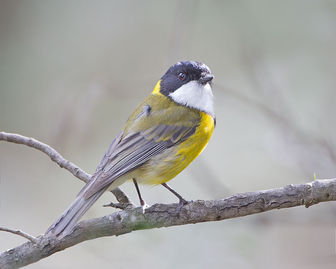Golden Whistler
In most subspecies, the male has a bright yellow underside and nape, olive-green back and wings, a black head and chest-band, and a white throat. A notable exception is the Norfolk Island Golden Whistler where the plumage of the male is female-like. The females are overall dull brownish-grey, though some have yellowish undertail coverts. Both sexes have a black bill, dark legs and red-brown eyes.

Original source: Own work
Author: JJ Harrison (http://www.noodlesnacks.com/)Camera location
The Golden Whistler is classified as Least Concern. Does not qualify for a more at risk category. Widespread and abundant taxa are included in this category.
The Golden Whistler belongs to the Family Pachycephalidae, which means 'thick-head' after the group's robust necks and heads. This species is one of Australia's loudest and most beautiful songsters. Identification The adult male Golden Whistler is bright yellow on the underside, olive-green on the back and wings, and black on the head with a bright yellow collar. The throat is white, separated from the yellow chest by a broad black band. The bill and legs are black. Females lack bright plumage. More
Female Golden Whistler at nest with young. Female Golden Whistler at nest with young. Photo: G. More
International, but is called the Mangrove Golden Whistler in Australia (where it is endemic). © Ian Montgomery; please contact: ian@birdway.com. More
The Australian Golden Whistler (Pachycephala pectoralis) is a species of bird found in forest, woodland, mallee, mangrove and scrub in Australia (except the interior and most of the north) and in mountain forest in the Snow Mountains in the Papua Province of Indonesia. Most populations are resident, but some in south-eastern Australia migrate north during the winter. More
The Norfolk Island Golden Whistler (Pachycephala pectoralis xanthoprocta), also known as the Norfolk Island Whistler or Norfolk Island Thickhead, and locally as the “Tamey”, is a small bird in the whistler family, Pachycephalidae. It is a subspecies of the Australian Golden Whistler (Pachycephala pectoralis) and is endemic to Norfolk Island, an Australian territory in the Tasman Sea, between Australia and New Zealand. More
Identification: The male golden whistler has grey-olive upper parts, black wings with inner feathers edges dull yellow. Head is black, encircling a white throat. Shoulders, back of neck and breast are bright yellow. Females have upper and lower plumage various shades of olive-grey. Belly and breast are buff. Call/Song: Produces a rather melodious, loud, persistent and clear whistling notes. For example, chee-chee- chee-chee-tu-whit. More
GOLDEN WHISTLER: Pachycephala pectoralis 17 cm * In Australia the Golden Whistler is distributed widely in forests and woodlands of the east. * In north Queensland it occurs mainly in upland rainforests. * The sulphur-yellow and olive-green body plumage, with a white throat and black head markings, make the male conspicuous. More
Australian Golden Whistlers have a strong, musical voice. Taxonomy - The taxonomy of the Golden Whistler complex is difficult, and remains a matter of dispute. Some authorities include a wide range of – often strikingly different – taxa from Indonesia, East Timor, Papua New Guinea, the Solomon Islands, Vanuatu and Fiji as subspecies of P. More
Golden Whistler Size: 17cm Habitat: Found from Cooktown in North QLD to the Eyre Peninsular in the South, as well in Southern WA. This bird inhabits most kinds of dense forest, its diet consists of insects, grubs and small fruits. Notes: Male: Black head black band under white throat yellow body. Female: Grey. Breeds Spring-Summer. For more information on Golden Whistler see references. Images have been uploaded in low resolution for storage efficiency, ( they do not reflect the true image quality). More
Aspects of the topic golden whistler are discussed in the following places at Britannica. More
A male Golden Whistler (Pachycephala pectoralis), photographed in the Greater Bendigo National Park. EXIF: Canon EOS 50D : 1/400 sec : f/6.3 : 400 mm : ISO 160 Categories: Photoblogs.org - The Photoblogging Resource View My Profile coolphotoblogs.com Birding Top 500 Counter VFXY Photos Vazaar photo blogs, top photoblogs 3761016 visitors | 1000 photos | RSS 2. More
Golden Whistlers are much less common west of the dividing range than they are in the east. They are also more uncommon than Rufous Whistlers. After a first sighting at our former neighbour's property, 20 km south of Narrabri, New South Wales in 2003, it took us 3 years and a trip to the east coast to see another Golden Whistler, in May of 2006 in the Royal National Park, south of Sydney. More
Golden Whistler ( Pachycephala pectoralis ) = Golden Whistler | Pachycephala pectoralis photo Male Golden Whistler. Image by Julian Robinson - Some rights reserved. Golden Whistler | Pachycephala pectoralis photo Golden Whistler Image by Julian Robinson - Some rights reserved. GOLDEN WHISTLER FACTS - Description The male Golden Whistler has olive green back and wings and bright yellow underside. More
Golden Whistler call of a female Pachycephala pectoralis christophori (0:42) Niels Krabbe XC33055 30-11-2006, Solomon Islands Golden Whistler call of a female Pachycephala pectoralis christophori (0:26) Niels Krabbe XC33056 30-11-2006, Solomon Islands Golden Whistler call of a female Pachycephala pectoralis christophori (0:14) Niels Krabbe XC33059 30-11-2006, Solomon Islands More

Original source: Arthur Chapman
Author: Arthur Chapman
Permission: Some rights reserved
Family : Pachycephalidae
Genus : Pachycephala
Species : pectoralis
Authority : (Latham, 1801)

